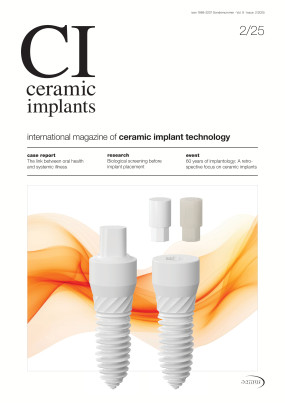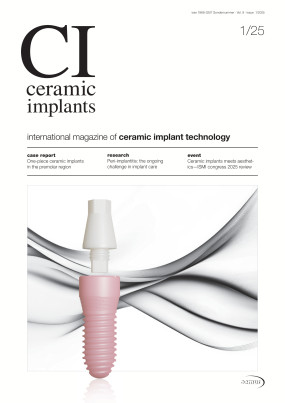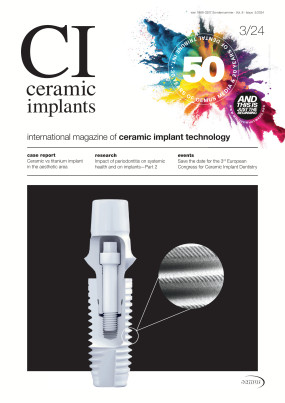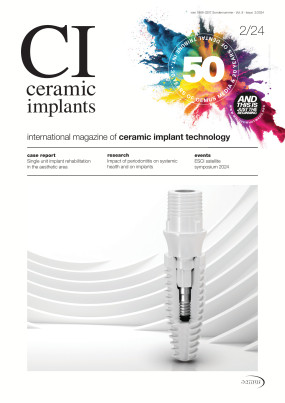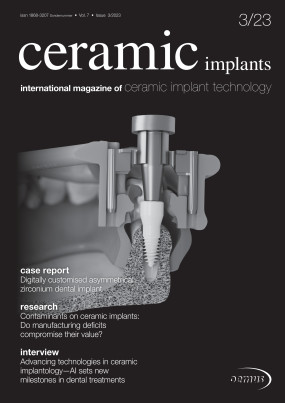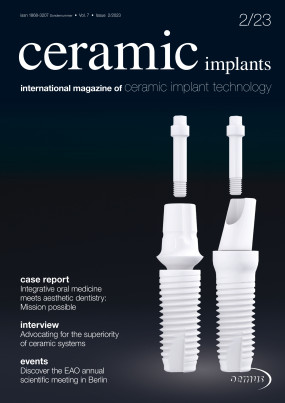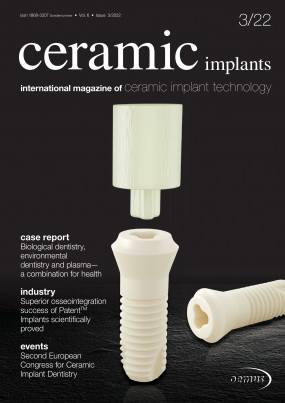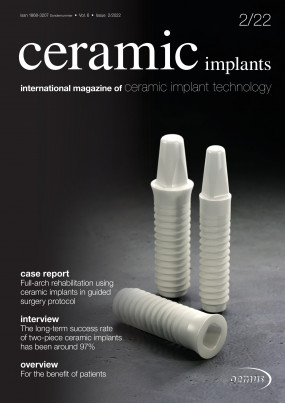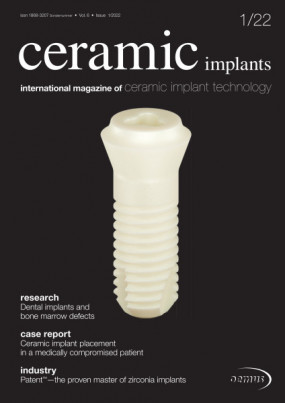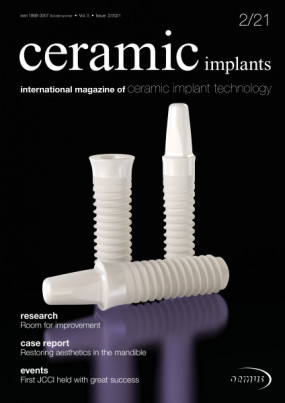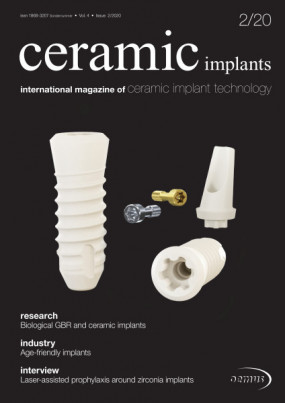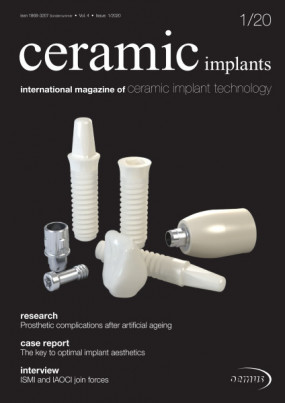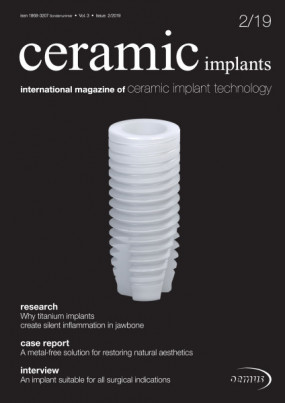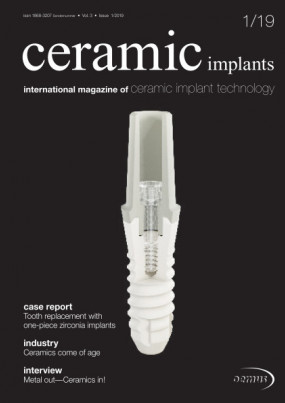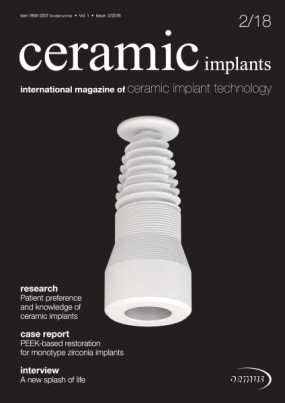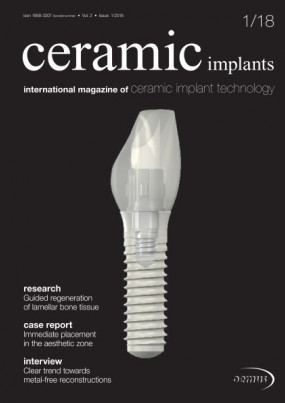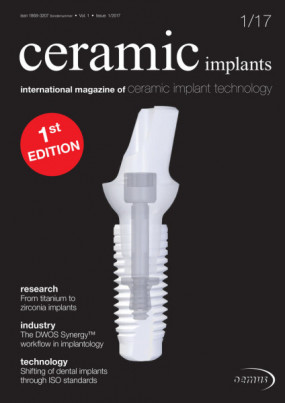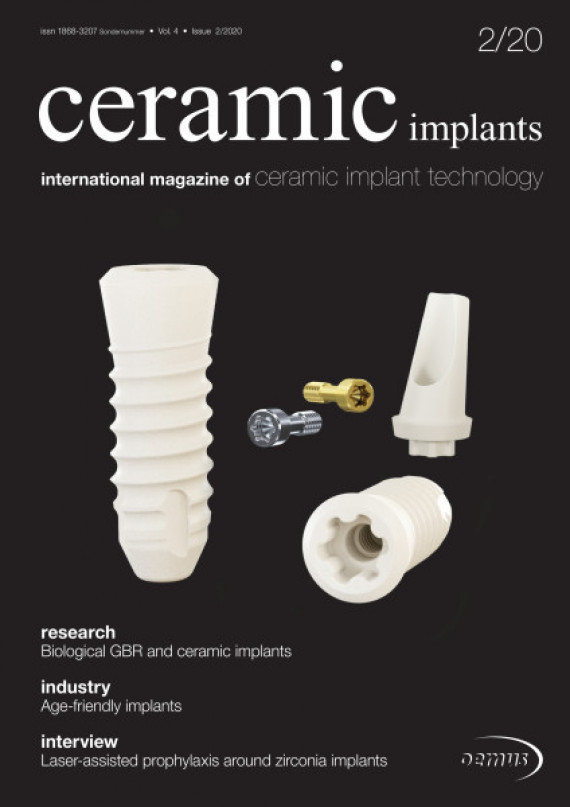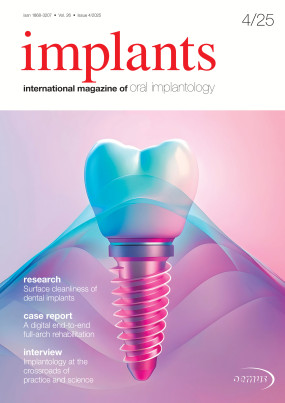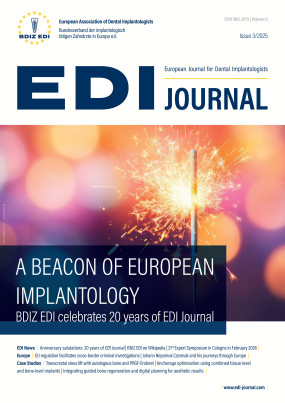Inhaltsverzeichnis
1
3
Cosmetically, a great deal can be concealed nowadays. However, what about sustainability? Have we as dental professionals not made the attempt to achieve restitutio ad integrum our highest goal? In oral surgery, this applies above all to the difficile rehabilitation of tooth gaps in the anterior area, which has unfavourable anatomical conditions for single-tooth restorations with dental implants...
4
6
Since the market entry at the end of the 1990s, the number of inserted zirconium oxide implants has been steadily increasing. Today, however, they constitute only an estimated three to 5% of all inserted implants world-wide. Market analyses predict a significant rise in the coming years (Dental Implants Market Research Report 2017). This trend is due to the increasing confidence in the material zirconium oxide, the evolution from one-piece to two-piece configuration, as well as optimised abutment connections on ceramic implants...
14
The transition from acute local inflammation after surgical removal of third molars to a chronic stage of silent inflammation could be a neglected cause of inexplicable medical symptoms. In this case report, we present an unusual case of recurrent syncope in a 19-year-old woman, whose 12-month treatment in various clinics, including a wide range of medications, did not lead to an improvement in her condition...
16
Biological guided bone regeneration and ceramic implants
Dr Karl Ulrich Volz, Dr Stephanie Vergote, Dr Rebekka Hueber & Dr Josephine Tietje, Switzerland; Dr Tobias Wilck & Prof. Shahram Ghanaati, Germany
Nowadays, there are still many patients who have lost significant bone volume as a result of tooth extractions and who therefore require bone augmentation measures. In the following second part of the article series
20
Zirconium-dioxide as preferred material for dental implants
1 Professor for Implant Dentistry at the College of Medicine & Dentistry (Ulster University in Birmingham, UK); 2 EACIm Ambassador to the UK and The Netherlands; 3 Professor and Dean at the College of Medicine & Dentistry (Ulster University in Birmingham,
Zirconia has several other interesting characteristics what makes it an ideal product to apply in dentistry, not only for crowns, but also for dental implants and implant abutments...
24
The latest generation of two-piece ceramic implants (zirconia) is considered an alternative treatment option to titanium implants owing to their excellent biological and material properties.1–11 Their handling and workflow now meet the requirements of modern implantology.12 In the following, a clinical case is described to demonstrate the use of a two-piece ceramic implant...
28
Ceramic versus titanium implants
Drs Simion Bran, Manea Avram, Onisor Gligor Florin, Horia Opris, Gabrial Armencea & Mihael Baciut, Romania
In this study, we followed up the comparative tissue reaction to titanium dental implants versus ceramic dental implants. Both types of dental implants used were mainly those produced by TAV Dental. Only two-piece dental implants were used in this research. The following parameters were evaluated in each step of the procedures: quality of the prosthetic attachment, gingival attachment, dental plaque adherence, and primary and secondary stability. In all of these cases, implant uncovering and prosthetic loading were done ten weeks after implantation. In the two cases described here, there were no observable complications after implant insertion...
30
Ceramic implants: an alternative or a primary choice?
Dr Riccardo Scaringi, Dario Viera & Dr Michele Nannelli, Italy
Today, grade 2 titanium is considered the standard material for prosthetic implant rehabilitation in all situations that may arise in the dental field. The excellent bone integration, good tissue biocompatibility, resistance to corrosion and biomechanical stress mean that titanium implants are an optimal clinical solution, including with regard to the standardisation of surgical protocols that have made it possible to obtain solutions with an acceptable result even in the hands of less experienced practitioners..
36
Life expectancy in the world population is gradually increasing thanks to better living conditions, more widespread healthcare and greater economic resources. The ageing of the individual is accompanied by changes in some bodily functions, such as a decrease in sensory activities, flexibility, nutrition, blood circulation and cognitive abilities. Normal tissue involution, poor hygiene and insufficient care often lead to periodontal disease with tooth loss and bone atrophy, often aggravated by osteoporosis and concomitant systemic disease...
40
Dental implants made of titanium and titanium alloys are considered a gold standard in implant dentistry due to their exceptional mechanical properties and longterm clinical success.1 However, the main drawback of a titanium implant is its dark grey colour, which may occasionally be visible through the peri-implant mucosa, hence influencing aesthetic outcomes, specifically in thin mucosal areas and anterior region. Therefore, a ceramic implant is turning out to be a more and more popular treatment option designed in anticipation of achieving a better aesthetic outcom...
42
Zirconia is the hardest material used to make dental implants. Its 3D positioning when used in its monobloc form determines prosthetic success without impinging on biological requirements. It is common to have a vestibular edge of the shoulder corrected in order to avoid overburial and follow the mucosal margin for aesthetics or a vestibular edge of the abutment to respect a more palatal or lingual insertion axis and spare the vestibular bone wall. These corrections must be limited in volume and time in order to avoid permanent damage to the zirconia and jeopardising of its mechanical strength by hindering crystallographic healing...
44
50
Available in both one- and two-piece configuration, the novel Patent™ dental implant system is based on the central idea that “less is more”—fewer surgical steps and no screws or other components that are not necessarily needed. In this interview, Frédéric Wehrli, Director of Product Management, reveals the details about the fully customisable ceramic implantsystem...
52
Peri-implantitis is an increasing problem today. It is especially associated with titanium implants. What treatment benefits does the laser offer in this context? Indeed, peri-implantitis is a real scourge for which we do not yet have good therapeutic solutions. Dr Stefan Renvert said in his 2012 book, “As in all pathologies, the best form of treatment is very often prevention and peri-im-plantitis is no exception.”1 From this point of view, the Er:YAG laser can provide us with certain solutions for the daily practice...
54
Owing to the travel and other restrictions that have arisen from the COVID-19 pandemic, the annual meet-ing of the International Society of Metal Free Implantology (ISMI), originally scheduled to take place in May in Berlin in Germany, was postponed, and with it also the regularly held members’ meeting. On the last weekend of September, however, an autumn conference of ISMI was organised in the Swiss Biohealth Clinic in Kreuzlingen in Switzerland, and within this context, the postponed members’ meeting took place...
